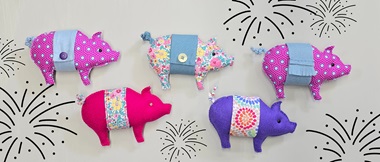
Sarah’s diary - how to sew a simple apron
Why sew an apron? First off, I love cooking, so I go through a fair few aprons a year (yep, I’m a messy cook!). Also, for beginner sewists, they’re a quick project that you can turn around in an afternoon.
For this project I chose a bright, easy-to-wash cotton. A busy, colourful pattern is better for hiding stains, and I need something that can withstand being placed in the washing machine at least once a week.
Because apron sewing can be very simple, I chose to make the project a little more difficult and add bias tape to the edges of the apron. You don’t need to do this and can simply finish off the apron by turning over the edges and sewing down. However, I thought this would be a good way to practise some new skills – and it makes the apron look more professional. I chose a contrasting bias tape and ribbon for the straps, so the colours really pop!
As I have quite a few aprons, I used one from my kitchen as a template. If you don’t have an apron to measure around, there are plenty of free templates on the internet. You can even sketch your own out on the fabric if you feel confident enough.
You will need:
- An apron to use as a template or a paper template
- 1m fabric of your choice – a thick cotton, thin denim or waxed cloth is great
- 2m bias tape
- 2m woven ribbon
- Pins
- Scissors
- Chalk
- Thread in contrasting colour to bias tape
- Sewing machine – we used the Brother Innov-is A80

Step 1
Wash and iron your fabric to prep it before you work with it.Step 2
Fold your fabric in half lengthways, right sides touching so that the wrong side is the one you can see.Step 3
Fold the apron you’re using as a template in half lengthways and place the fold of the apron on the fold of the fabric. Or fold the apron template paper in half lengthways and place the fold of the template on the fold of the fabric. Trace around the outer edge of the apron template in chalk or disappearing pen and then remove the apron template. You don’t need to mark a seam allowance for this project.
Step 4
Cut out around the markings and then open out.
Step 5
Turn the apron wrong side up and open up the bias binding. Pin the right side of the bias binding to the edge of the wrong side of the apron. Start with the bottom edge of the apron.
Step 6
Select straight stitch and set it at a 4mm length. Stitch in the quarter fold of the bias binding all the way to the end.
TIP: Make sure to backstitch at the beginning and end of the stitching to secure, as per other pieces.

Step 7
Trim the bias to be flush with either side of the apron. Then bind the arm holes, trim flush.Step 8
After you’ve bound the bottom edge and arm holes, bind the top of the apron and the two sides. Instead of lining the end of the binding and cutting the end flush, leave 1cm of binding at each end of the edge. Cut the corners of each overhanging edge of the binding into a point, fold over flush with the edge of the apron and stitch in place on the wrong side of the apron.
Step 9
Once all the binding has been done, take the woven ribbon and measure round your neck to get the right length for you. Measure 2.5 cm from the edge of the apron and pin the end of the ribbon to the wrong side of the top of the apron on both sides. Make sure you don’t twist the strap. Sew in place.
Step 10
Place the apron over your head and take the remaining woven ribbon, tie round your waist to get the right size for you, including the bow, and cut. Then cut in half.
Step 11
Take one of the straps and pin to the wrong side of the apron where the arm hole meets the drop of the side of the apron. Select straight stitch and drop the length to 2.5cm and stitch a square round the edges of the strap. Repeat on the other side with the other piece of the woven ribbon.
Step 12
Fold the raw edge of each piece of woven ribbon and stitch together to prevent fraying.
Step 13
Go cook!What did I learn?
- Washing and ironing your fabric before you use it is important – not just for aprons, but for anything you make (as long as the material is machine washable). I didn’t wash the material for the first apron I made. The first time I cleaned it the whole apron warped (as fabric often shrinks the first time it is washed). It came out very lopsided – it was put in the scraps pile after that.
- It’s better to fold your fabric and template apron in half and draw your pattern on the fold, rather than drawing round your entire template apron. You’ll get a much more symmetrical and neater cut.
- My table isn’t very big, so I cut my material on the floor as there’s lots of space and it’s flat. Just be careful of any carpets or rugs!
This apron is a great project to brighten up your home, but also makes a great gift too! Who would you make one for?




